RC Scale
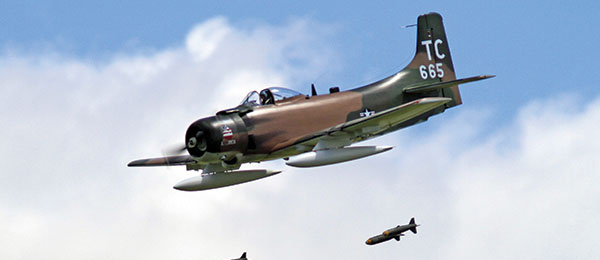
Written by Stan Alexander What is scratch-built? As seen in the April 2018 issue of Model Aviation.
Building is an open subject, especially for modelers. After reading multiple discussions online about what some consider scratch-built, plan-built, kit-built, or an ARF, I’ll try to explain it and hope that it doesn’t upset anyone. Here it goes. Scratch-building a Scale model is taking a set of scale drawings (such as three-views) that show the outlines of the full-scale aircraft and then measuring the drawings. Add to that photos and other documentation that you have. The drawings are scaled up and a set of working plans from which to build are made.
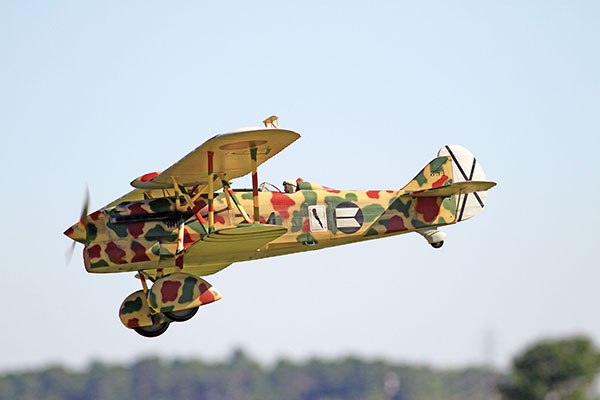
Larry Botsford’s scratch-built Fiat CR.32 has a 98-inch wingspan, is powered by an O.S. BGX-1 3500 engine, and is painted with Klass Kote.
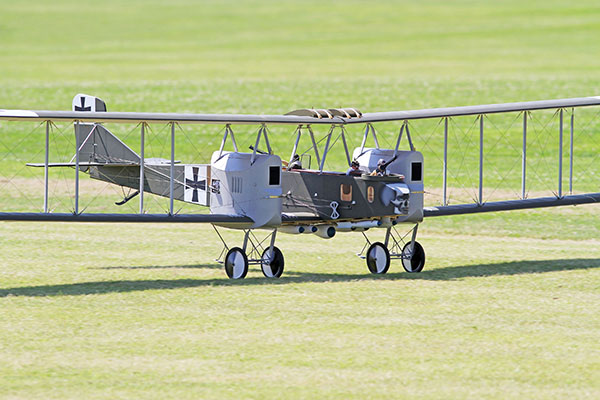
Greg Hahn’s Gotha G.IV is completely scratch-built with a 17-foot wingspan. Powered by two DLE-40 twin engines, it’s painted with Randolph dope and covered with Solartex.
Parts from the plans are cut out with a band saw or laser cutter and you begin to assemble the model. The aircraft is later covered and painted, and the scale details are finished. Next are plan-built models. You can purchase, borrow, or find free plans then use these plans to cut out the parts, sticks, etc. Sometimes you can purchase a short kit, which usually consists of the shaped and formed parts, but you are still building from plans.
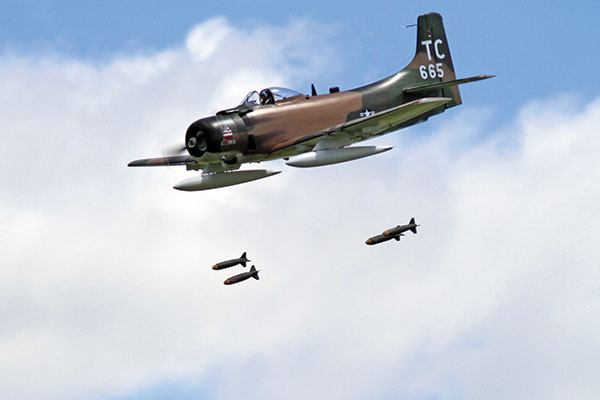
Greg Hahn’s plan-built model of a Nick Ziroli-designed Douglas Skyraider was enlarged to a 120-inch wingspan and uses a DLE-120 twin engine. Here it is shown on a bombing run.
Remember that all plans are not created equally. AMA has more than 8,000 sets of plans available through the AMA Plans Service, many of which are Scale models, but they run the entire spectrum of aeromodeling. On tap next is the kit-built model. You purchase a kit, such as a Sig Manufacturing 1/4-scale J-3 Cub, then order all of the gear, covering, paint, markings, etc. and build from its included plans and instructions.
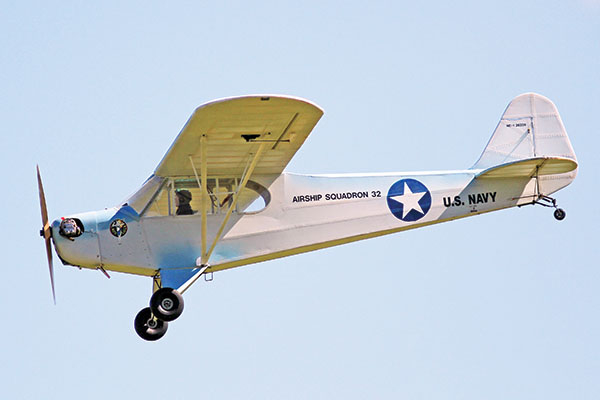
Ted Roman’s Sig Manufacturing 1/4-scale J-3 Cub is shown in Airship Squadron 32 colors. It’s powered by an O.S. 1.60 twin engine.
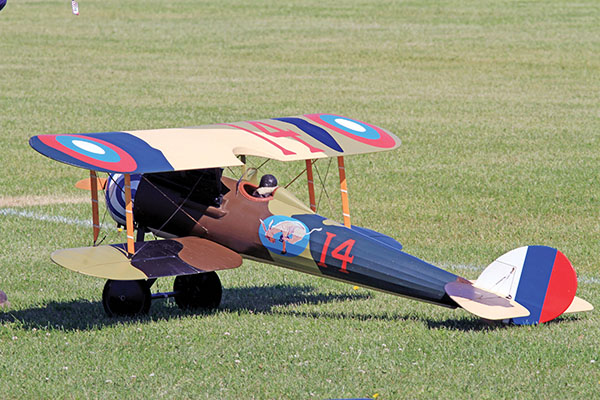
Randy Adams had this Balsa USA kit of a Nieuport 28C entered in Fun Scale. Built by Doug Cox, it uses a Zenoah G26 engine for power.
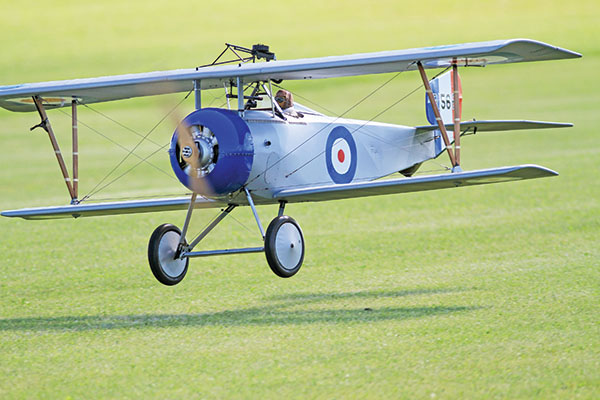
A 1/3-scale Balsa USA kit was the basis for Steve Eagle’s beautiful Nieuport 17. The 114-inch wingspan model is powered by a 3W 100 engine and is painted with automobile paint.
ARFs are usually delivered in huge boxes and are generally prefinished. You must add the gear, hardware, and radio system, but the hard stuff is mostly done for you. Believe it or not, you can compete in RC Scale with an ARF in the Fun Scale class. There are fiberglass kits, carbon-fiber kits, balsa/plywood kits, and a seemingly endless variation of models from which to choose. I like plan-built models, and you can make modifications to plan-built, kit-built, or scratch-built models—ARFs, not so much, but adding details to any model is half the fun.
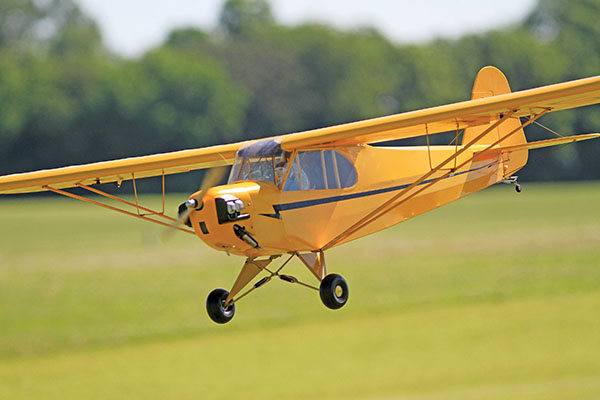
Dale Arvin’s Balsa USA 1/4-scale J-3 Cub has a wingspan of 108 inches. It uses an O.S. FS-120 engine for power. The covering is MonoKote, and it’s controlled by a Futaba radio system.
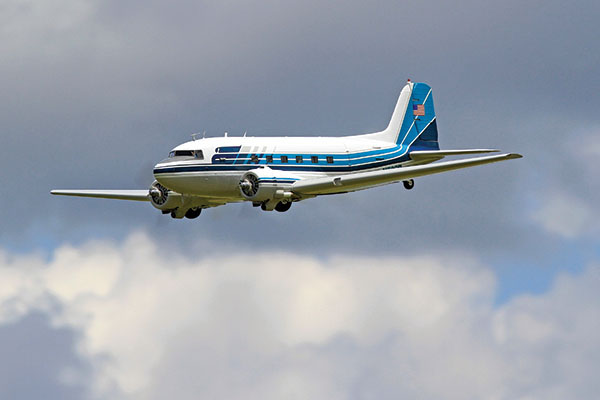
Adam Grubb’s beautiful DC-3 was built from a Fiber Classics kit. The model is painted with automobile paint. It features a 120-inch wingspan and it’s powered by two Y.S. 115FZ engines.
New Scale Plans!
Jerry Bates Plans has several new sets of plans for 2018. The 1/3-scale Rearwin 6000M Speedster has a length of 88.5 inches, a 128-inch wingspan, weighs 28 to 32 pounds, and uses an 80cc or larger engine. The plans cost $60. The only full-scale flying example known to me is a bright red Speedster that was restored and was at EAA AirVenture in Oshkosh, Wisconsin, several years ago. The Mitsubishi A5M4 Claude is designed to 1/4 scale with a wingspan of 1081/4 inches. It was the predecessor to the A6M Zero and used mostly by the Japanese Imperial Navy as a carrier-based fighter. It does not have retracts! The model aircraft had fixed gear with wheel pants, and the wing is designed to come apart in three sections for transport. It’s fully aerobatic as well. The plans sell for $65.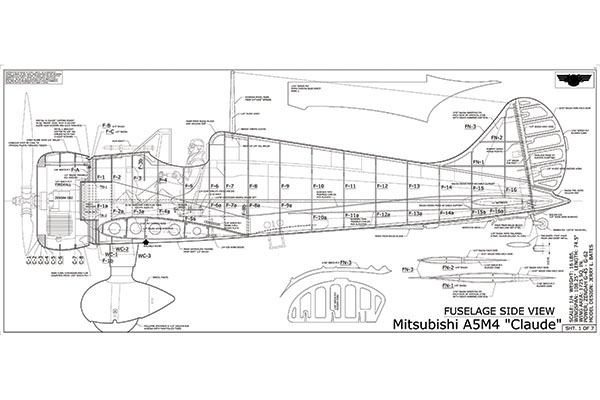
A sideview of Mitsubishi A5M4 Claude plans created by Jerry Bates. The model features a 108.25-inch wingspan.
Jerry Bates has been drawing airplanes since he was a kid. He is one of the few designers who is still publishing plans and producing parts for his designs. All of his plans are drawn in CAD, so his plans are easier to understand, read, and build from. A “proof of model” is always built with Jerry’s plans, so when you purchase his plans, they are well thought out with the servo installation, engine, hinges, and other small items that many designers don’t include.
The following is an autobiography written by Jerry Bates and gives a history of how he became a plans maker and model designer.
Jerry Bates had a passion for airplanes and drawing even before he could walk. He was born in the Panama Canal Zone to two ex-Marines who served during World War II. His dad worked for a government organization that was tasked with mapping Central and South America. He was chief cartographer (mapmaker) and charged with seeing that the mapping equipment was set up and operating correctly in each country. To say the least, they moved around continuously. The organization had many ex-WW II aircraft for transportation and mapping, such as the C-46, C-47, DC-4, B-17, B-24, and A-26, as well as a couple of the “double-bubble” P-38s. There were numerous light airplanes and even a P-47 Razorback that was painted orange. Flying in those aircraft, and many others, was Jerry’s foundation for a love of military aviation. His dad’s early career as a mapmaker piqued Jerry’s interest in drawing what else, but airplanes.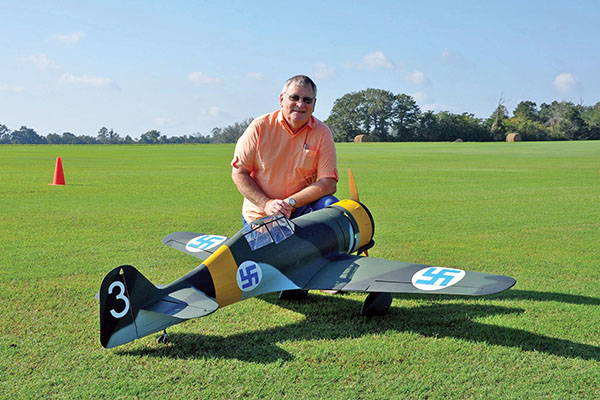
Jerry Bates’ Fokker D.XXI is finished in a pre-WW II Finnish Air Force color scheme.
When he was back in the Canal Zone, he was either building model airplanes or exploring the jungles with his brother. The Canal Zone was a major point for the return of equipment and supplies used in the Pacific War campaigns. Numerous aircraft were stored and rebuilt there and given to other countries. Those boneyards became their primary playground. Jerry’s parents returned to the United States in 1959. His dad continued his government employment and moved the family around every few years. The car bug bit Jerry by that time—he was in his early teens. Starting with sport car racing, stock cars, and then drag racing and street rods, it culminated with motorcycle racing and sales. Through all of this, he supported his family and his hobbies as a draftsman with several engineering firms. He recently retired from an engineering firm as a senior designer. Motorsports could not keep him away from the airplanes, though, as he continued to build and fly models. He concentrated on Control Line and worked his way up to Precision Aerobatics (Stunt) competition. Jerry was also building models for others, and that is how he got his introduction to RC models. He attended several RC Precision Aerobatics (Pattern) competitions, but just couldn’t make a comfortable connection with that area of the hobby. His RC friends got him to attend a couple of RC Scale competitions during this time. That did it for Jerry—the cars had to go in order to convert his shop and dedicate it to RC Scale aircraft models. It was during one of these visits that he was introduced to the late Jack Dorman of Fort Walton Beach, Florida. Jack became his mentor, teaching him many techniques and introducing him to the “big names” of our hobby/sport. Jack and Jerry collaborated on a 1:5.5-scale P-40E Warhawk. Jerry drew the plans and Jack built the model. They successfully campaigned the P-40 and that was the start of Jerry Bates Plans. At first, the plans were hand drawn. He would build the prototype model, fly it, and then make the molds for the various parts to be offered. Jerry did the vacuum forming and fiberglass part lay-ups as well. With a full-time job, it became difficult to find time for new plans because so much time was required to make the parts and fill the orders. He now has several fabricators who make and ship parts to his clients. There are also several vendors that supply retractable landing gear to suit the plans. Jerry has lately found a couple of builders to make some of the prototype models, allowing him time to make molds, etc., and thus having more time to develop new plans. The introduction of CAD has been a major change in the way plans are developed. In the past, drawing meant working on one set of plans at a time and staying with it until it was complete. CAD allows the development of several plans within the same timeframe—not because CAD is faster, but because you can save the files on a hard drive and simply access them at a keystroke for additional information as the need arises. CAD also offers the opportunity to develop plans with more accuracy of the parts fit. At any one time, Jerry has six to eight plans under development. Jerry’s path for the development of a set of plans might not be unique, but could be of interest, so we’ll lay out the process from conception to completion. First, an interest must be sparked. For Jerry, that is easy; if it has wings, he’s interested. But normally the spark comes from a suggestion that is received from someone in the modeling community. His interest in the aircraft is usually from a historic standpoint. Once the subject is selected, he collects all of the historical data he can find, any factory drawings or publications available, photographs, three- or four-view drawings, and available plastic kits and model plans about the subject. Jerry then selects the most accurate three-view upon which to base the plans. The three-view is compared with the information collected. If it proves to be scale, it will be used. Most often, though, the scale drawing is not scale, so he draws his own. If fortune smiles [upon him], he finds a full-scale subject to measure. With the scale drawing complete, the model plans can be developed. It might take six to 10 months to complete a set of plans, depending on how long it takes to collect the required data. After the plans have been completed, they are sent to several interested parties to critique. That process is used to check accuracy, construction technique, and to look for mistakes so that they can be made ready for construction. A laser-cutting file is created and sent to a cutter so that the prototype model can be built. Plans errors that are found during construction are fixed, and the plans and laser-cutting files are readied. The cowl and canopy models are made, and the plans are offered to the modeling community. Jerry’s plans are for the traditional type of balsa plywood construction. His philosophy for plans is to develop one with a scale outline, an airframe that is strong and lightweight, and one that utilizes the minimum number of parts to accomplish the building task. The advent of laser cutting makes this job easier because it allows for interconnecting parts. An airframe that builds quickly allows a modeler more time to incorporate scale details. The primary purpose for construction plans is to impart information to the builder. That makes the way information is displayed on plans of utmost importance. Careful use of line weights is used to display that information. Ease of construction is another important issue. The fuselages of most of Jerry’s models are built split along the engine thrustline. The top half is built on the top view of the fuselage plans. The horizontal and vertical stabilizers are added, along with the upper fuselage sheeting before removal from the workbench, making it easier to ensure that the stabilizers are square with the thrustline. That assembly can be removed from the plans and the bottom of the fuselage built directly onto the top half. That method minimizes built-in warps and allows for quick assembly. Wing halves are built directly on the plans, utilizing building tabs to provide the correct washout. Most of Jerry’s plans utilize the airfoils, incidences, and offsets of the full-scale subject. Both the size of the model and the radio systems that are offered today have made this combination successful. You might have noticed by the plans offered that they are primarily for lesser-known aircraft, or were developed for a specific scale, rather than the aircraft normally seen at the flying field such as the P-51D, Corsair, P-47, etc. Jerry enjoys doing plans for unusual aircraft. They might not have a large market, but the process sure must be fun. Time is still a constraint. You know the old adage—so many airplanes, so little time. That means he doesn’t have the time to fly much anymore. Jerry thought he would be missing that portion of the hobby more than he does, but he has as much fun drawing plans, and it makes it that much more enjoyable when he sees a model at the flying field that was built from his plans. Builders and fliers are the key to the hobby. When you get a chance to pass it on, do so! Jerry has said if you keep building them, he will keep drawing them.
Update on Cessna C-165 Airmaster
I didn’t get nearly as much work done in 2017 on my Cessna as I had hoped. Family illness and other things got in the way. But now I’m back on it and finishing up the wing, servos for the ailerons, and flaps, as well as a more scalelike set of landing lights and navigation lights.Tina Patton
Tina Patton is new to building Scale models and has tackled a good one as her first: a Balsa USA Sopwith Camel. Her husband, Bob, is a longtime designer and builder of large Scale models. I can’t wait to see the results.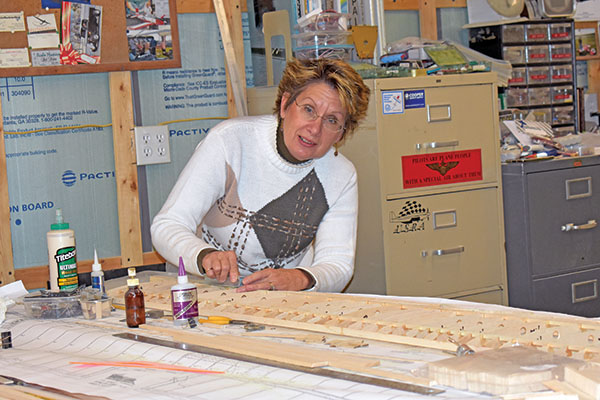
Tina Patton is shown with her first RC Scale model, a Balsa USA Sopwith Camel. The author looks forward to seeing it fly!
Fair skies and tailwinds
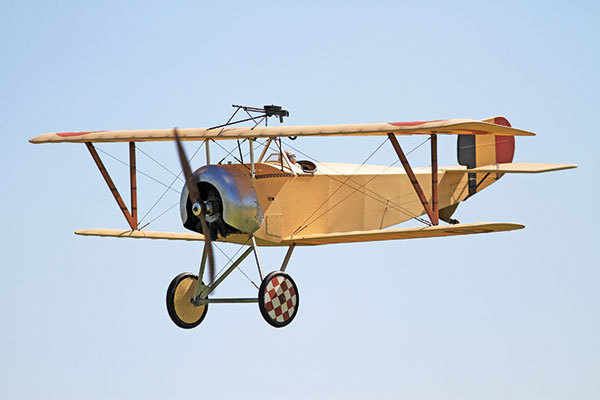
Another beautiful scratch-built model at the 2017 RC Scale Nats was Art Johnson’s 1/3-scale Nieuport II.
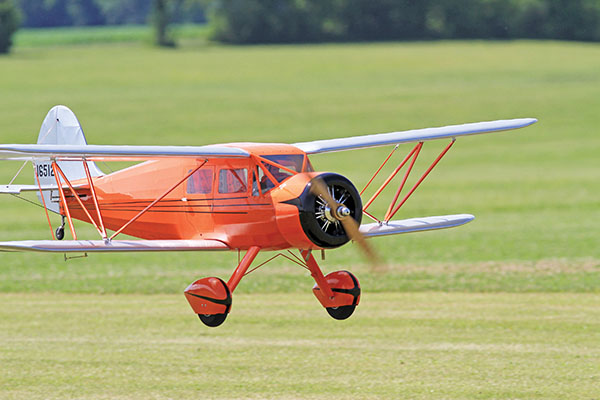
Adam Grubb’s Waco YKS-6 from Pilot-1 Airplanes is an ARF with a 100-inch wingspan. Its O.S. FR7-420 radial engine sounds great! Adam flew it in Fun Scale during the Nats.
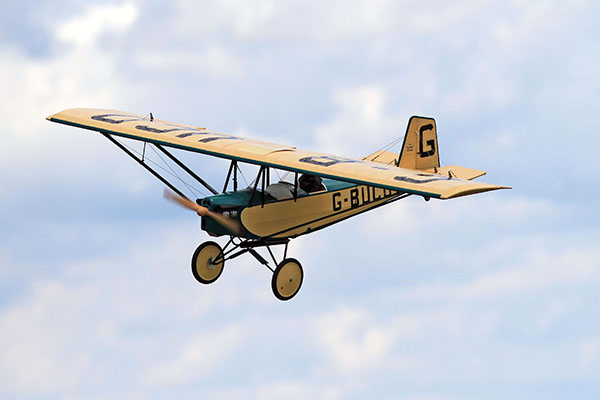










Add new comment